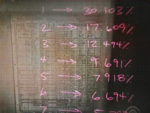 Quick, name any city, state, or country! Before you look up the population of that geographic area, what would you guess is the leftmost digit of that number?
Quick, name any city, state, or country! Before you look up the population of that geographic area, what would you guess is the leftmost digit of that number?
Similarly, what would you guess the odds are of that leftmost digit being, say, a 1?
Many people guess that the odds are no different from it being any other number, so they say 10%. While there are 10 digits, 0 can't be the leftmost digit of a population. So, there are actually only 9 choices.
“OK, so the odds are 1 in 9, or a probability of about 11.1%”, you might say. Surprisingly, the odds of the first digit of a randomly-chosen population, or a number representing just about any other naturally occurring quantity, being a 1 is more than 30%!
This very counter-intuitive observation is known as Benford's Law. It was first discovered in 1881 by Simon Newcomb, who noticed that the earlier pages of books of logarithm tables, which contained logarithms that began with the number 1, were far more worn than later pages. If you have, say, a dirty keyboard, you may have noticed a similar phenomenon.
In 1938, physicist Frank Benford rediscovered the principle, and researched it with a wider variety of data sets. This is why it's referred to as Benford's Law and not Newcomb's Law.
It's certainly an interesting observation, but what good does it do? Fortunately, James Grime is here to help us answer that question:
James Grime does go through some very complex explanations very quickly in the above video, so if you prefer to go through that information at your own pace, you may want to check out the article Looking out for number one, by Jon Walthoe.
Probably the most important thing to remember about Benford's Law, besides the distribution of the digits themselves, is when the Law applied. As has already been mentioned, when the data is too random, such as randomly chosen numbers, or too constrained, such as people's heights or ages (which only happen in a certain range), then the law doesn't apply.
Besides the population example with which I opened this post, another good random set of data would be something like Twitter. As a matter of fact, Christian S. Perone programmed his computer to lift numbers out of Twitter's public timeline, take a look at the first digit, and graph them. The video on his site shows the amazing results, with Benford's Law predictions in blue, and the twitter results in green. Note how they conform closer to the prediction as more tweets are read.
Fans of mathemusician Vi Hart will be glad to know that she gave her unique take on Benford's Law during a visit to Khan Academy. In part one of the video, she and Salman Khan discuss the mysteries of it. In part two of the video, they delve more into the whys and wherefores.
Of course, even when you understand the idea behind Benford's Law, it still seems surprising. For those who aren't familiar with it, the concept still seems mind-boggling. So, we've got a tool that works naturally in certain circumstances, yet produces surprising results when demonstrated. What do we do with such a tool? Correct, we use it to win money, as Brian Brushwood shows us in this week's Scam School:
Even with everything you may have learned at the earlier links, it's fascinating to watch the psychology behind the Scam School version of Benford's Law. One side is made to seem more attractive in the bet by being loaded with more numbers. Also, 4 is taken out of the equation entirely, so as to actually worsen the odd for the team that chooses the larger numbers (they're forced to use 5 through 9 instead of 4 through 9). About the only legitimate part remaining in the presentation is the lack of concern for the choices made, as long as they're not from too constrained or too random numbers.
The fact that you can present this in a bar without carrying an almanac (which some scammers used to do in the days before smartphones) makes this much more pleasant, as well.
Just out of curiosity, what was the population of your chosen geographic area at the beginning? Look it up now, and see if it would fall on the 1-3 side, the 5-9 side, or the no-man's land of 4.
1
Benford's Law
Published on Sunday, October 09, 2011 in fun, innumeracy, math, psychology, Scam School, self improvement, videos
Related Posts
Post Details
Posted by Pi Guy on Oct 9, 2011
Labels:
fun,
innumeracy,
math,
psychology,
Scam School,
self improvement,
videos
Subscribe to:
Post Comments (Atom)




1 Response to Benford's Law
Another video that gets at the old use of logarithms...
Ye olde logarithms:
http://youtu.be/HecaRGpaTWE
Post a Comment